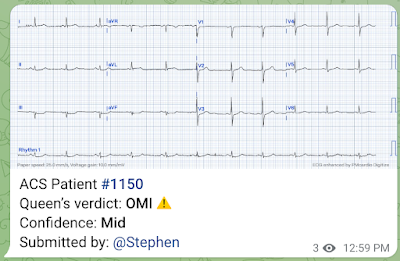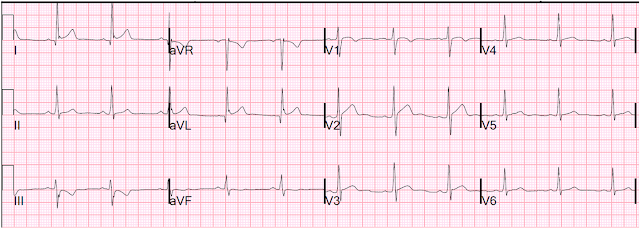I come in early for every shift to read the ECGs on the system that have not yet been "confirmed". I came across this one:
The computer calls is: "SINUS RHYTHM. NORMAL ECG"
Veritas algorithm
Be VERY careful when the computer calls the ECG "Normal".
I saw the inferior ST depression (which is reciprocal to subtle STE in aVL) and the subtle ST depression in precordial leads and thought: "If this patient came in with chest pain, then it is an acute OMI."
So I looked on the computer. Turns out that it was a 50-something patient with no previous cardiac history who had called 911 for chest pain and had presented 75 minutes earlier by ambulance to triage (as the entire ED was overloaded). After the ECG was recorded, he was placed in the waiting room where he had been for over an hour. All triage ECGs are immediately shown to triage ED faculty.
I went to triage and showed the ECG to our triage faculty, who is VERY good at reading OMI on the ECG, and he immediately recognized the findings. In his hurried state he had not looked closely enough, probably because the computer had said "NORMAL ECG," AND because a bunch of misinformed authors have propagated the idea that we need not look at triage ECGs that the computer calls "NORMAL."
I sent this ECG to the Queen of Hearts (PMcardio OMI), and here is the verdict:
We brought the patient to the stabilization room. The patient stated that his pain was now much better, suggesting spontaneous reperfusion and that the ECG would show resolution of the findings.
So we recorded another ECG 77 minutes after the first:
I sent this ECG to the Queen of Hearts (PMcardio OMI), and here is the verdict:
The next day I was able to find the prehospital ECG:
I sent this ECG to the Queen of Hearts (PMcardio OMI), and here is the verdict:
Case 1
Case 2
Case 3
===================================
MY Comment, by KEN GRAUER, MD (7/12/2023):
===================================
Dr. Smith has entitled today's post, “Be VERY careful when the computer calls the ECG Normal”. Having spent decades studying (and comparing) the ECG interpretations of numerous cardiologists, internists and hospitalists (as I was collecting “data” for the ECG books I was writing) — I would take this statement a step further by saying — If YOU are responsible for the care of a given patient — Do not accept what anyone else says about an ECG until YOU yourself have seen the actual ECG.
- These words of caution are especially relevant with tracings like those that we see in today’s case.
- P.S.: I long ago learned the importance of viewing the actual ECG myself the hard way ...
-USE.png) |
| Figure-1: I've reproduced and labeled the first 2 tracings in today's case. |
- IF the clinical scenario for ECG #1, was that this tracing was recorded in an ambulatory care setting from an otherwise stable patient with longstanding coronary disease but no new chest pain — then I would interpret this ECG as showing "nonspecific" ST-T wave abnormalities that are probably not acute.
- IF on the other hand — the clinical scenario in which ECG #1 was recorded, was of a patient who presented to the ED for new chest pain (which was precisely the clinical scenario in today's case for this patient) — then we need to be aware of the concept of "pseudonormalization" in a patient with OMI, in which the "culprit" artery has spontaneously opened. (See My Comment at the bottom of the page of the May 18, 2023 post — and the April 9, 2023 post — as well as in many other of our posts on Dr. Smith's ECG Blog).
- To Emphasize: ECG #1 is not "normal". That said — the ST-T wave changes that we see in ECG #1 are subtle, and easily overlooked if not given adequate attention.
- Possibility #3: Many of us are charged with the responsibility of overreading the ECGs interpreted by others. This is precisely the situation Dr. Smith encountered in today's case. As a result — since he saw this initial ECG #1, but did not know what the history was, nor what transpired clinically in the case — Dr. Smith recognized the need to find out this information!
- "Take-Home" Lessons from Point #1: Although the findings in ECG #1 are subtle — Once we inquire about the history (ie, that this patient presented to the ED for new chest pain that apparently lessened during the time he was placed in the waiting room) — We need to be aware that the reason acute OMI findings may be subtle in these circumstances, is that the "culprit" artery may have spontaneously reopened.
- We also need to remember that prior to development of the QoH (Queen Of Hearts) AI application — computerized ECG interpretations were notorious for not recognizing subtle OMI findings during the phase of pseudonormalization. As per Dr. Smith — We can not trust a computer interpretation of "normal" in a patient with new chest pain.
- As per Dr. Smith — There is slight-but-real ST depression in each of the inferior leads in ECG #1. More than this — there is ST segment flattening in these leads (best seen in leads III and aVF of ECG #1 — as suggested by the RED outline that I've drawn above these leads).
- The "magic" mirror-image opposite ST-T wave picture that we highlight so often in Dr. Smith's ECG Blog is seen between lead III and lead aVL (Don't the inverted = mirror-image ST-T waves in the RED inserts in ECG #1 highlight this mirror-image relationship?).
- There is loss in ECG #1 of the normal slight, upward-sloping ST elevation that we usually see in leads V2 and V3. I've drawn BLUE arrows in lead V3 and lead V4 of this tracing to highlight subtle-but-real ST depression in these leads — that in a patient with new chest pain indicates posterior OMI until proven otherwise.
- IF this repeat ECG #2 had been the only ECG available — one would be hard pressed to say it was diagnostic of anything. But the GREEN arrows that I've drawn in ECG #2 clearly show that the subtle-but-real inferior ST depression and lead aVL ST elevation that had been present in ECG #1 is no longer seen!
- In association with the clinical history of reduced chest pain — these GREEN arrows highlight "dynamic" ST-T wave changes — that of itself confirms the need for prompt cath and PCI.
- "Take-Home" Lessons from Point #3: Although some clinicians might question the need for prompt cath given resolution of both chest pain and associated ECG changes — the fact that this patient's chest pain returned after ECG #2 was recorded highlights the clinical reality that PCI is still essential — because a "culprit" artery that spontaneously reopens — may just as easily spontaneously close again. Prompt PCI is indicated to prevent this.
- Finally — All too many clinicians in my experience fail to evaluate serial ECGs by meticulous lead-to-lead comparison. Putting sequential tracings together (as I have done in Figure-1) — makes serial comparison of subtle changes much easier (as highlighted by the GREEN arrows in ECG #2). In contrast — quick perusal of ECG #2 without placing ECG #1 right next to it invites missing the finding of dynamic ST-T wave changes in ECG #2.













No comments:
Post a Comment
DEAR READER: I have loved receiving your comments, but I am no longer able to moderate them. Since the vast majority are SPAM, I need to moderate them all. Therefore, comments will rarely be published any more. So Sorry.